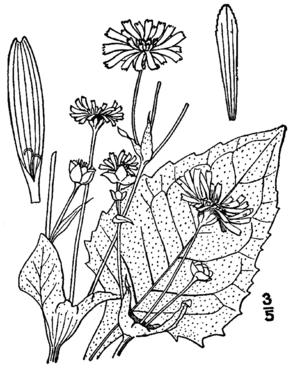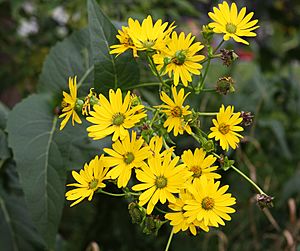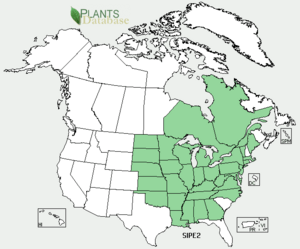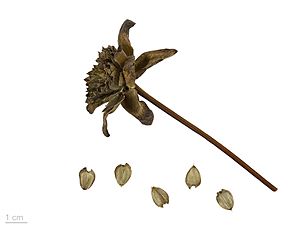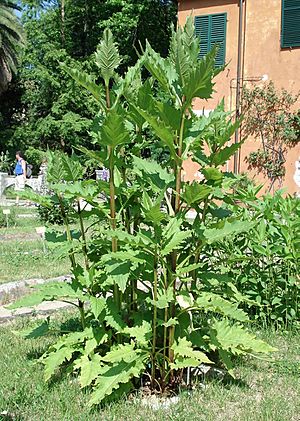Cup plant facts for kids
Quick facts for kids Cup plant |
|
|---|---|
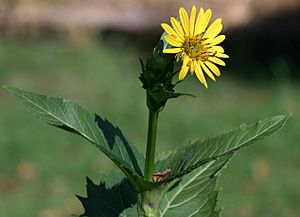 |
|
| Scientific classification |
The Cup Plant, also known as Silphium perfoliatum, is a tall, leafy plant with bright yellow flowers. It belongs to the daisy family and is originally from eastern and central North America. This plant is special because its leaves join together around the stem, forming a little cup that can hold water.
The scientific name perfoliatum means "through the leaf," which perfectly describes how its leaves look like they're pierced by the stem.
There are two main types of Cup Plant:
- S. perfoliatum var. connatum
- S. perfoliatum var. perfoliatum
Contents
What is the Cup Plant?
The Cup Plant has several interesting common names:
- Cup plant
- Cup-plant
- Carpenter's weed
- Cup rosinweed
- Compass plant
- Pilot weed
- Squareweed
- Indian cup
How Does the Cup Plant Look and Grow?
Where Does the Cup Plant Live?
The Cup Plant loves to grow in moist, sandy areas. You can often find it near streams or in open woodlands. It is native to many states in the USA and provinces in Canada.
In some places, like Michigan, the Cup Plant is a threatened species. This means it's becoming rare and needs protection. However, in New York State, it's considered an invasive species. This means it can spread too much and harm other native plants.
What Does the Cup Plant Look Like?
Cup Plants are quite tall, usually growing between 1 and 2.5 meters (about 3 to 8 feet) high. Their stems are strong, smooth, and have four distinct square sides, much like a mint plant.
The leaves are opposite each other on the stem and have jagged edges. The most unique part is how the leaves connect around the stem. They form a cup shape that can collect rainwater. The first flower grows at the very top of the main stem, and then more flowers appear on the side branches.
What Do the Flowers Look Like?
The flowers of the Cup Plant bloom from mid-summer into autumn. They look a lot like small sunflowers, usually about 2.5 cm (1 inch) wide. They have bright golden-yellow petals, called ray florets.
In the center of the flower are tiny, tube-shaped disk florets. These disk florets are mostly for show and don't produce seeds.
How Does the Cup Plant Make Seeds?
The yellow petals (ray florets) of the Cup Plant are female parts. They develop into thin, brown seeds called achenes. These seeds have a small wing, which helps the wind carry them away to new places.
Insects like bees, butterflies, and skippers are important pollinators. They help move pollen between flowers, which allows the plant to produce seeds. Each flower head can create 20 to 30 seeds. Each seed is flat and about 9 to 15 mm long.
How Does the Cup Plant Spread?
The Cup Plant can also spread without seeds. It has a main taproot that goes deep into the ground. It also has shallow underground stems called rhizomes. These rhizomes can grow new plants, forming large groups or "colonies."
Some Cup Plant roots found in gardens are thought to be over 50 years old! Because of its strong root system, it's hard to move an older Cup Plant once it's established.
How Does the Cup Plant Survive?
The Cup Plant is very tough and can handle extreme weather. For example, its roots can survive freezing temperatures as low as -30°C (-22°F) in winter. The best temperature for it to grow is around 20°C (68°F).
What is the Cup Plant Used For?
Using the Cup Plant for Energy
The Cup Plant is being studied as a possible "energy crop." This means it could be grown to produce energy, especially for making biogas. Biogas is a type of fuel made from natural materials. The Cup Plant is good for this because it doesn't need much special care, soil, or specific weather. It also produces a lot of plant material (biomass).
In Germany, farmers are growing more Cup Plants for biogas. It's not expected to become an invasive problem in Central Europe. However, it's important to be careful when growing it near rivers, as seeds could spread along the banks.
Growing Cup Plants for Energy
Cup Plant seeds don't always sprout easily, so farmers often plant young seedlings instead of seeds. This costs more at first. Also, you can't harvest the plant in its first year. It only starts producing a lot of biomass from the second year onwards.
One idea to help farmers is to plant Cup Plants with corn in the first year. This way, they can still harvest corn while the Cup Plant gets established.
Is the Cup Plant Affected by Diseases?
Cup Plants are generally strong and resist most diseases and pests. However, a fungus called Sclerotinia can sometimes affect older plants. If a Cup Plant gets this fungus, it can often recover the next year.
Many animals enjoy the Cup Plant. American Goldfinches love to eat its seeds and drink the water collected in the leaf-cups. Dense groups of Cup Plants also provide good hiding places for birds. Farm animals like cattle and sheep will eat the leaves, especially when the plants are young.
Why Grow Cup Plants Instead of Corn for Energy?
Growing Cup Plants for energy has many benefits:
Good for the Environment
- After the first year, you don't need herbicides (weed killers).
- Its thick roots protect the soil from washing away.
- Little or no fertilizer is needed after the first year.
- It improves soil quality and helps soil organisms like earthworms.
- It reduces soil erosion and flood risks.
- No soil is compacted (squashed down).
- No pesticides are needed after the first year.
- It provides cover for small wild animals.
Good for Farmers' Wallets
- Wild pigs don't eat it, so it doesn't cause damage to crops.
- You don't need to buy new seeds every year because it's a perennial plant. It can be harvested for up to 20 years!
- Lower costs for planting new crops.
- Less need for machines to work the soil.
- It's very tough against dry weather (if planted in deep soil) and cold winters.
- If a storm knocks down the stems, they don't get in the way of new growth in spring.
- Young Cup Plants can handle light frosts, unlike corn.
- Growing Cup Plants reduces risks in years with bad weather for corn.
- You can harvest Cup Plants over a longer period, which makes farm work easier.
- Long-lasting crops save money over time.
Some farmers are still unsure about growing Cup Plants because there's no harvest in the first year. But planting it with corn can solve this. Also, it's best to grow Cup Plants for at least 5 years to make up for the first-year costs.
Can the Cup Plant Become Invasive?
Even though it's native to North America, the Cup Plant has been called invasive in some US states. This is a big discussion when thinking about using it for biofuel.
Scientists use a "Weed Risk Assessment" to figure out if a plant might become invasive. Traits that are good for biofuel plants, like growing fast and needing little care, are also common in invasive plants. The Cup Plant fits these traits. However, its seeds don't sprout easily, so it might not spread as much as other invasive plants. Also, farmers could harvest the plants before the seeds are fully ready to spread.
Using the Cup Plant for Animal Food
Besides energy, the Cup Plant can also be used as food for animals. It contains good things like amino acids, carbohydrates, and vitamins. It's considered good food for farm animals that produce meat and milk because it lives a long time and has high protein levels.
Farmers can store the Cup Plant as silage (fermented animal feed). It's best to harvest it twice a year, otherwise, the stems become too tough.
The Cup Plant flowers for eight weeks or more. This long blooming period and lots of flowers provide a great food source for bees, which helps with honey production. The honey from Cup Plants is rich in fructose and doesn't crystallize quickly. A field of Cup Plants can produce about 150 kg (330 pounds) of honey per hectare each year!
Using the Cup Plant for Medicine
The Cup Plant produces a sticky substance called resin, which smells a bit like turpentine. This resin has been used for medicine.
Native Americans would cut the top of the plant's stalk to collect this resin. They would chew it like gum to freshen their breath and to help with nausea (feeling sick to your stomach) and vomiting.
The Winnebago Tribe believed that a special drink made from the root would give them supernatural powers. They would drink this before hunting. The Chippewa Tribe used root extract for back and chest pains and to treat lung bleeding. In spring, the young, soft leaves were even cooked or eaten in salads.
Powdered Cup Plant is thought to help with fevers, dry coughs, asthma, and problems with the spleen, heart, and liver. Studies show that extracts from the leaves can help lower cholesterol levels in the blood. It also seems to help the body fight off sickness and can help the gallbladder produce bile, which helps with digestion.
Using the Cup Plant in Gardens
The Cup Plant's bright flowers make it a beautiful addition to gardens, attracting many pollinators like bees and butterflies. Its seeds and the water collected in its "cups" also attract birds, providing them with food and water.
The Cup Plant was brought to the United Kingdom and the Soviet Union in the 1750s and has been popular as an ornamental plant ever since. It even won an award from the Royal Horticultural Society in the UK!
You can find Cup Plants at many plant nurseries, especially those that sell native plants. They are often used in natural-looking gardens and in projects that restore prairies and meadows. A large group of Cup Plants was planted in Millennium Park in Chicago, Illinois, in 2010. In gardens, it looks best when planted in groups rather than alone, as its tall flower stalks are less likely to fall over when supported by other plants.
Images for kids


